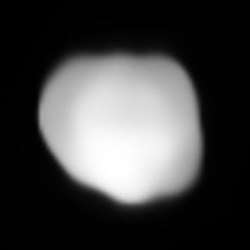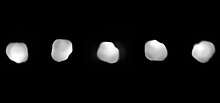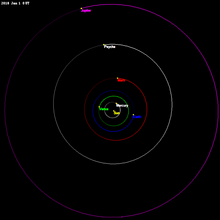16 Psyche
16 Psyche /ˈsaɪkiː/ is one of the most massive asteroids in the asteroid belt. This object is over 200 km (120 mi) in diameter and contains about 1% of the mass of the entire asteroid belt. It is thought to be the exposed iron core of a protoplanet,[8] and is the most massive metallic M-type asteroid. Psyche was discovered by the Italian astronomer Annibale de Gasparis on 17 March 1852 from Naples and named after the Greek mythological figure Psyche.[9] The prefix "16" signifies that it was the sixteenth minor planet in order of discovery.
 | |
| Discovery | |
|---|---|
| Discovered by | Annibale de Gasparis |
| Discovery date | 17 March 1852 |
| Designations | |
| (16) Psyche | |
| Pronunciation | /ˈsaɪkiː/[2] |
Named after | Psychē |
| Main belt | |
| Adjectives | Psychean /saɪˈkiːən/[3] |
| Orbital characteristics[4] | |
| Epoch JD 2453300.5 (22 October 2004) | |
| Aphelion | 3.328 AU (497.884 Gm) |
| Perihelion | 2.513 AU (375.958 Gm) |
| 2.921 AU (436.921 Gm) | |
| Eccentricity | 0.140 |
| 4.99 yr (1823.115 d) | |
| 323.379° | |
| Inclination | 3.095° |
| 150.352° | |
| 228.047° | |
| Physical characteristics | |
| Dimensions | 279 × 232 × 189 km ( ± 10% )[5] |
Mean radius | 112.5±2 km[6] |
| (1.658±0.250)×105 km2 | |
| Volume | (6.074±1.215)×106 km3[5] |
| Mass | (2.41±0.32)×1019 kg[1] |
Mean density | 3.99±0.26 g/cm3[1] |
Equatorial surface gravity | ~0.015 g |
Equatorial escape velocity | ~180 m/s[5] (~600 ft/s) |
| 4.195948±0.000001 h[5] | |
| 0.15±0.03 0.37±0.09 (radar)[5] | |
| Tholen = M [4] SMASS = X [4] Bus-DeMeo = Xk [7] | |
| 9.22 to 12.19 | |
| 5.90[4] | |
Symbol
Astronomers created icon-like symbols for the first fifteen asteroids to be discovered, as a type of shorthand notation consistent with older notation for the classical planets. Psyche was given an iconic symbol, as were a few other asteroids discovered after 16 Psyche. The symbol ![]()
However the iconic symbols for all asteroids were superseded and Psyche's symbol never came into use. With more than a dozen asteroids discovered, remembering all their individual emblems became increasingly unwieldy, and in 1851, German astronomer J.F. Encke suggested using a circled number instead: ⑯. The first new asteroid that was designated in 1852 using this new scheme was 16 Psyche, when American astronomer James Ferguson published his observations.[11]
Characteristics
Mass, size and shape

Psyche is massive enough that its gravitational perturbations on other asteroids can be observed, which enables a mass measurement. The values for the mass of 3.38±0.28×10−11M☉ and the density of 6.98±0.58 g/cm3 obtained from a 2002 analysis by Kuzmanoski and Kovačević, of a close encounter with asteroid (13206) 1997 GC22.[12] The new, high density estimate suggests that 16 Psyche must be composed mostly of metals. As of 2019, the best mass estimate is (2.41±0.32)×1019 kg, with a derived bulk density of 3.99±0.26 g/cm3.[1]


The first size estimate of Psyche came from IRAS thermal infrared emission observations. They showed that it had a diameter of about 253 km,[4] although it was likely an overestimate as Psyche was viewed pole-on at that time.[5][13]
Light curve analysis indicates Psyche appears somewhat irregular in shape. There is a pronounced mass deficit near the equator at about 90° longitude comparable to Rheasilvia basin on Vesta. There are also two additional smaller (50–70 km in diameter) crater-like depressions near the south pole. Psyche's north pole points towards the ecliptic coordinates β = 28°, λ = −6°, with a 4° uncertainty.[6][14] This gives an axial tilt of 95°.[5]
Observations of two multi-chord stellar occultations of 2010 and 2014[15] allow the matching of light curve inversions DAMIT model 1806[16] that give an equivalent-volume mean diameter of 216±12 km, and an equivalent surface mean diameter of 227±13 km. The density of Psyche derived from these estimates – 3.7±0.6 g/cm3 – is consistent with that of other metallic asteroids.[6]
Observations of Psyche with Very Large Telescope's adaptive optics SPHERE imager revealed two large craters, which were informally named Meroe and Panthia, after the twin witches in the Roman novel Metamorphoses by Apuleius.[1]
Composition and origin
Radar observations indicate that Psyche has a dense and largely metallic composition,[17][18] consistent with it having one of the highest radar albedos in the asteroid belt (0.37±0.09).[5] Psyche seems to have a surface that is 90% metallic and 10% silicate rock,[19][20] with 6±1% of orthopyroxene.[21][22] Scientists think that these metals may be mostly iron and nickel.[23]
The NASA Infrared Telescope Facility at the Mauna Kea Observatories reported evidence (~3 μm absorption feature) of hydroxyl ions on the asteroid in October 2016 that may suggest water ice. Since Psyche is thought to have formed under dry conditions without the presence of water, the hydroxyl may have reached Psyche via past impacts from smaller carbonaceous asteroids.[24][25][26][27]
Psyche appears to be an exposed metallic core or a fragment of a metallic core[21] from a larger differentiated parent body some 500 kilometers in diameter. If Psyche is indeed one, there could be other asteroids on similar orbits. However, Psyche is not part of any identified asteroid family.[28] One hypothesis is that the collision that formed Psyche occurred very early in the Solar System's history, and all the other remnants have since been ground into fragments by subsequent collisions or had their orbits perturbed beyond recognition. However, this scenario is considered to have a probability of just 1%. An alternative is that Psyche was broken by impacts, but not catastrophically torn apart. In this case, it may be a candidate for the parent body of the mesosiderites, a class of stony–iron meteorites.[28]
Another possibility is that Psyche may be an endmember of diverse relic bodies left by the inner planet formation. The asteroid's mantle may have been stripped away not by a single collision but by multiple ( > 3 ) relatively slow side-swipe collisions with bodies of comparable or larger size. What is left is a metallic core covered by a thin layer of silicates, which reveals itself spectrally. In such a case Psyche would be analogous to Mercury but much less massive.[29]
Exploration

No spacecraft has visited Psyche, but in 2014 a mission to Psyche was proposed to NASA.[30][31] A team led by Lindy Elkins-Tanton,[8] the director of the School for Earth and Space Exploration at Arizona State University, presented a concept for a robotic Psyche orbiter. This team argued that 16 Psyche would be a valuable object for study because it is the only metallic core-like body discovered so far.[31]
The spacecraft would orbit Psyche for 20 months,[30] studying its topography, surface features, gravity, magnetism, and other characteristics and would be based on current technology, avoiding high cost and the necessity to develop new technologies. On 30 September 2015, the Psyche orbiter mission was one of five Discovery Program semifinalist proposals.[32]
The mission was approved by NASA on 4 January 2017 and was originally targeted to launch in October 2023, with an Earth gravity assist maneuver in 2024, a Mars flyby in 2025, and arriving at the asteroid in 2030.[33] In May 2017 the launch date was moved up to target a more efficient trajectory, launching in 2022, with a Mars gravity assist in 2023 and arriving in 2026.[34]
On February 28, 2020, NASA awarded SpaceX a $117 million contract to launch the Psyche spacecraft, and two smallsat secondary missions, on a Falcon Heavy rocket in July 2022.[35]
See also
References
- Viikinkoski, M.; Vernazza, P.; Hanuš, J.; Le Coroller, H.; Tazhenova, K.; Carry, B.; et al. (6 November 2018). "(16) Psyche: A mesosiderite-like asteroid?" (PDF). Astronomy & Astrophysics. 619 (L3). arXiv:1810.02771. Bibcode:2018DPS....5040408M. doi:10.1051/0004-6361/201834091.
- Noah Webster (1884) A Practical Dictionary of the English Language
- "psyche". Oxford English Dictionary (3rd ed.). Oxford University Press. September 2005. (Subscription or UK public library membership required.)
- "JPL Small-Body Database Browser: 16 Psyche" (2008-09-19 last obs). Retrieved 4 December 2008.
- Sheppard, Michael K.; Richardsonb, James; Taylor, Patrick A.; et al. (2017). "Radar observations and shape model of asteroid 16 Psyche". Icarus. 281: 388–403. Bibcode:2017Icar..281..388S. doi:10.1016/j.icarus.2016.08.011.
- Hanuš, J.; Viikinkoski, M.; Marchis, F.; Ďurech, J.; Kaasalainen, M.; Delbo', M.; Herald, D.; Frappa, E.; Hayamizu, T.; Kerr, S.; Preston, S.; Timerson, B.; Dunham, D.; Talbot, J. (2017). "Volumes and bulk densities of forty asteroids from ADAM shape modeling" (PDF). Astronomy & Astrophysics. 601 (A114): 1–41. arXiv:1702.01996. Bibcode:2017A&A...601A.114H. doi:10.1051/0004-6361/201629956.
- "EAR-A-5-DDR Taxonomy v 6.0". Planetary Data System. Archived from the original on 17 December 2015. Retrieved 16 April 2018.
- Elkins-Tanton, L.T.; Asphaug, E.; Bell, J.; Bercovici, D.; Bills, B.G.; Binzel, Richard P.; et al. (March 2014). "Journey to a Metal World: Concept for a Discovery Mission to Psyche" (PDF). LPI Contribution No. 1777. 45th Lunar and Planetary Science Conference. p. 1253. Bibcode:2014LPI....45.1253E. Retrieved 5 October 2015.
- Schmadel, Lutz D. (2012). Dictionary of Minor Planet Names (6th ed.). Springer Science & Business Media. pp. 14–15. ISBN 3642297188.
- Sonntag, A. (1852). "Elemente und Ephemeride der Psyche". Astronomische Nachrichten. 34 (20): 283. Bibcode:1852AN.....34..283.. doi:10.1002/asna.18520342010.
[in a footnote] Herr Professor de Gasparis schreibt mir, in Bezug auf den von ihm März 17 entdeckten neuen Planeten: J'ai proposé, avec l'approbation de Mr. Hind, le nom de Psyché pour la nouvelle planète, ayant pour symbole une aile de papillon surmontée d'une étoile.
- Hilton, James (17 September 2001). "When did the asteroids become minor planets?". U.S. Naval Observatory. Archived from the original on 25 August 2009. Retrieved 3 April 2007.
- Kuzmanoski, M.; Kovačević, A. (2002). "Motion of the asteroid (13206) 1997 GC22 and the mass of (16) Psyche" (PDF). Letters to the editor. Astronomy & Astrophysics: L17–L19. doi:10.1051/0004-6361:20021444.
the first successful attempt based on a dynamical method
- Lupishko, Dmitrij F. (2006). "On the bulk density and porosity of M-type asteroid 16 Psyche". Solar System Research. 40 (3): 214–218. Bibcode:2006SoSyR..40..214L. doi:10.1134/S0038094606030051.
- Kaasalainen, M.; et al. (2002). "Models of twenty asteroids from photometric data" (PDF). Icarus. 159 (2): 369. Bibcode:2002Icar..159..369K. doi:10.1006/icar.2002.6907. Archived from the original (PDF) on 16 February 2008. Retrieved 16 May 2006.
- "Asteroid Data Sets". sbn.psi.edu. Retrieved 26 May 2018.
- "DAMIT 1806". astro.troja.cuni.cz. asteroid 3D data archive.
- Ostro, S.J. (1985). "Radar observations of asteroids and comets". Publications of the Astronomical Society of the Pacific. 97: 877. Bibcode:1985PASP...97..877O. doi:10.1086/131619.
- Magri, C.; et al. (1999). "Mainbelt Asteroids: Results of Arecibo and Goldstone Radar Observations of 37 Objects during 1980–1995" (PDF). Icarus. 140 (2): 379. Bibcode:1999Icar..140..379M. doi:10.1006/icar.1999.6130.
- [Mission to a Metallic World: A Discovery Proposal to Fly to the Asteroid Psyche.] Future Planetary Exploration. 18 February 2014.
- Callahan, Jason (30 March 2015). "Discovery lives". The Space Review. Retrieved 30 March 2015.
- Hardersen, Paul S.; Gaffey, Michael J. & Abell, Paul A. (2005). "Near-IR spectral evidence for the presence of iron-poor orthopyroxenes on the surfaces of six M-type asteroid". Icarus. 175 (1): 141. Bibcode:2005Icar..175..141H. doi:10.1016/j.icarus.2004.10.017.
- Sanchez, Juan; Reddy, Vishnu; Shepard, Michael K.; Thomas, Cristina; Cloutis, Edward (2016). Compositional characterization of asteroid (16) Psyche. AAS Division of Planetary Sciences meeting #48. Bibcode:2016DPS....4832520S.
- 16 Psyche - Quick Facts. NASA. 16 May 2019.
- Atkinson, Nancy. "Pure Metal Asteroid Has Mysterious Water Deposits". Universe Today. Retrieved 11 November 2016.
- Simpson, Julia. "Giant Metallic Asteroid Psyche May Have Water". Politicallore. Retrieved 12 November 2016.
- Jesse Emspak (27 October 2016). "Giant Metallic Asteroid Psyche May Have Water". space.com. Retrieved 18 September 2017.
- Takir, Driss; Reddy, Vishnu; Sanchez, Juan A.; Shepard, Michael K.; Emery, Joshua P. (2016). "Detection of water and/or hydroxil on asteroid (16) Psyche". The Astronomical Journal. 153: 31. arXiv:1610.00802. Bibcode:2017AJ....153...31T. doi:10.3847/1538-3881/153/1/31.
- Davis, D.R.; Farinella, Paolo & Francesco, M. (1999). "The missing Psyche family: Collisionally eroded or never formed?". Icarus. 137 (1): 140. Bibcode:1999Icar..137..140D. doi:10.1006/icar.1998.6037.
- Asphaug, E.; Reufer, A. (2014). "Mercury and other iron-rich planetary bodies as relics of inefficient accretion". Nature Geoscience. 7 (8): 564–568. Bibcode:2014NatGe...7..564A. doi:10.1038/NGEO2189.
- Chang, Kenneth (6 January 2017). "A Metal Ball the Size of Massachusetts That NASA Wants to Explore". The New York Times. Retrieved 7 January 2017.
- Wall, Mike (15 January 2014). "Strange Metal Asteroid Targeted in Far-Out NASA Mission Concept". Space.com. TechMedia Network. Retrieved 16 January 2014.
- Brown, Dwayne C.; Cantillo, Laurie (30 September 2015). "NASA selects investigations for future key planetary mission". NASA TV. NASA. Retrieved 5 October 2015.
- Northon, Karen (4 January 2017). "NASA Selects Two Missions to Explore the Early Solar System". NASA. Retrieved 4 January 2017.
- "NASA Moves Up Launch of Psyche Mission to a Metal Asteroid". NASA. 24 May 2017. Retrieved 24 May 2017.
- Falcon Heavy to launch NASA Psyche asteroid mission, Jeff Foust, Space News, February 28, 2020
External links
- "Shape model deduced from lightcurve" (PDF). Archived from the original (PDF) on 16 February 2008.
- 16 Psyche at AstDyS-2, Asteroids—Dynamic Site
- 16 Psyche at the JPL Small-Body Database
